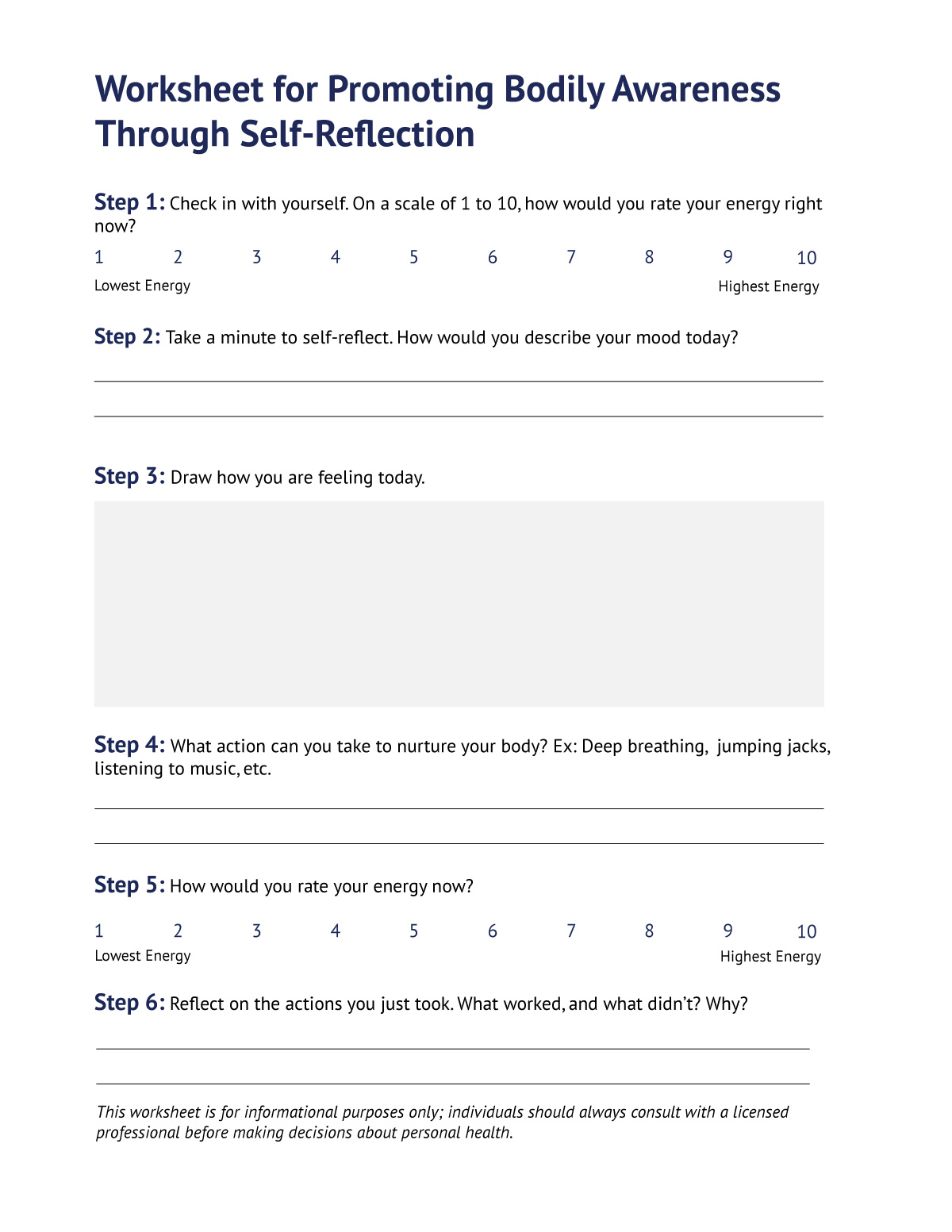How to Teach Kids About Body Awareness

Most children learn about the five senses, but rarely is proprioception—the sense of bodily awareness—included in those lessons. Learning about bodily awareness can encourage children to be more in tune with their physical and emotional needs and to feel empowered to ask for help with meeting those needs.
“There are so many internal feelings that we don’t get to see as therapists, parents or teachers,” said Dr. Katherine Saint, an adjunct professor of applied behavioral analysis at the Pepperdine Graduate School of Education and Psychology. “If we can teach our kids to recognize those things and know what to do about it, we’re going to prevent so many problem behaviors.
Dr. Saint said that clinicians like behavioral analysts often teach children with neurological disorders about body awareness, but there’s merit in bringing these lessons into larger classroom settings. She spoke about what body awareness is, why it matters, and how to teach children of different ages.
What Is Body Awareness?
Clinically, bodily awareness is referred to as proprioception, which is the sense of knowing where parts of your body are and how they feel. For example, without looking down, you know which foot is in front of the other or when one of your arms has fallen asleep.
Conceptually, body awareness can also encompass the complex mind-body connection; the way our bodies feel relates to shifting emotions and mental states. The habits and activities people choose to practice each day can contribute to the way they feel emotionally and physically.
For example, feeling stomach movements can indicate that a person is hungry and, for prolonged periods of time, make them feel irritable, angry or unable to concentrate.
Body awareness and mindfulness can help with sensory processing issues, including symptoms related to neurodivergent conditions like autism spectrum disorder, ADHD, ADD and OCD. Occupational therapists often teach neurodivergent children about body awareness so they can accurately recognize their body’s needs and respond with compassion and affirmation.
Dr. Saint said bodily awareness isn’t dependent on a specific disorder, but rather each individual child’s needs.
Benefits of Teaching Bodily Awareness
- Preventing problematic behavior.
- Developing a deeper understanding of needs.
- Creating better habits of self-care.
- Supporting academic performance.
- Helping with depression or anxiety.
- Managing bodily changes through puberty.
- Developing emotional intelligence.
- Promoting independence and autonomy.
Incorporating Bodily Awareness into Learning Environments
Dr. Saint said the best way to be more movement-oriented is to think creatively about how kids learn and develop in an educational setting.
“In a lot of school settings, kids are expected to sit still in their desks, but there’s so much research about how kids learn better during movement,” she said. “A strategy we try to use with our teens is figuring out how to let them move in a way that’s not disruptive or distracting their peers.”
This can involve teaching them how to identify what they need for their bodies and how to communicate this to the appropriate people.
Studies on classroom physical activity analyzed by the Centers for Disease Control and Prevention (PDF, 2.7MB) show that academic performance improves dramatically when students are encouraged to practice movement between lessons and during educational activities. The report also found that increased time spent on physical activity as a class was not likely to detract from performance, even when it takes away from time spent on the lesson.
“People think learning has to happen at a table or in a really structured environment,” Dr. Saint said. “Most things can be taught in an active way, but it requires the educator to kind of think outside the box and look for creative ways to do that.”
She said strategies can include small additions to the classroom environment, such as:
- Resistance bands on chairs that provide seated movement without being loud.
- Fidget tools attached to writing utensils to stimulate hand movement.
- Stand-up desks to promote blood flow and stabilize energy levels.
- Stretch breaks to signal a physical transition when moving to a new lesson.
- Outdoor classes to demonstrate the application of lessons to the real world.
- Chalk and other sidewalk drawing tools to promote full-body movement.
Online school systems have a unique challenge for K-12 students who need frequent movement throughout the day, but are expected to sit in the same seat for hours while isolated from other classmates.
Dr. Saint said the monotonous structure of sedentary and isolated learning in an online environment can lead to headaches, noncompliance and low energy. She suggested online teachers plan virtual, movement-based activities throughout the day, and verbally encourage students to take breaks to stretch or move around. She also said teachers should encourage students to communicate what they need, which requires training on awareness and self-reflection.
“Moving our bodies produces dopamine that increases motivation and happiness,” she said. “If we don’t move enough, our bodies get depleted and that’s where the feeling of being in a funk or a bad mood develops. So movement is a really powerful and consistent way that we can get the chemicals that our bodies need.”
The goal isn’t to have unlimited dopamine and energy.
“The goal is to have enough energy to meet your own values,” Dr. Saint said. Identifying values that matter to each child can be a means of helping them understand the long-term benefits of body awareness and self care.
Body awareness can help with various values, such as improving academic performance, getting enough sleep, sustaining attention spans during class, staying hydrated and nourished, and more.
Of course values will vary among children, and are bound to change as they age. But Dr. Saint said self-reflective questions, journaling and other strategies can help kids identify what matters to them, and help them practice body awareness in a way that meets their needs.
Strategies for Teaching Kids about Bodily Awareness
The development of body awareness begins at birth and continues through every stage of life as children grow and learn how to recognize and respond to feelings of hunger, pain, excitement, apprehension and more.
Dr. Saint said conversations about the body and labeling different sensations can be helpful before kindergarten as preparatory training. Labeling different sensations can be very simple:
“I can see that you are cold right now! Let’s get you another layer to wear!”
“You are so hungry! Let’s get some food!”
“If we teach kids at a young age to recognize what’s going on in their bodies, we can prevent some dysfunctional coping mechanisms,” she said. Those maladaptive mechanisms may include emotional eating, aggression, impatience and other disruptive behaviors.
Younger children have a fundamental understanding of physical needs, while older children often have developed an emotional intelligence that can attach a physical need with an emotional one.
Dr. Saint said it’s important to focus on the individual level because children of the same age might be at different developmental stages or have different physical and developmental needs depending on a neurological disorder or other variables.
“It’s all about tailoring it to the individual and what their needs are,” Dr. Saint said. “It doesn’t matter what your diagnosis is, as long as you can pinpoint where you are struggling.”
One activity Dr. Saint encourages for kids is the practice of checking in with their own bodies and minds at the beginning of a therapy session. By working on an individual level, kids are able to focus on themselves without comparing their needs to others.
“Asking for reflection is a huge part of the process and you have to train yourself to be aware,” she said. “A big part of how we train ourselves to be aware is having somebody ask us to self-reflect.”
Click the button below to download a worksheet PDF for individual body awareness check-ins for kids.

Individual body awareness check-ins for kids worksheet (PDF, 988KB)
Dr. Saint said she uses this strategy in one-on-one counseling, and encourages kids to keep a journal of the activities that improve their moods and keep them calm. Her strategy is focused on helping young people be more aware of any personal triggers and identify what works as a response.
“The goal is to fade those prompts out so that they don’t need someone to prompt them,” she said, “so they will recognize on their own in the early stages of developing symptoms.”
For older kids, Dr. Saint said it’s easier to develop protocols they can follow when they’re starting to notice symptoms that need attention. When kids are given the training and the resources for taking better care of themselves, they can build the skills to identify their own needs and the confidence to reach out for help.
“People often wait until things are really bad to start doing those reactive measures,” she said, “but if we can increase their awareness they can intervene sooner and prevent their mental health from going downhill.”
Additional Resources about Teaching Bodily Awareness:
- Body Awareness Activities for Children, Your Therapy Source
- Meditation for Kids, Headspace
- Mindfulness for Kids, mindful.org
- Body Awareness, National Safe Place
- Tools for Positive Classroom Environment, Online Physical Education Network
Citation for this content: OnlinePsychology@Pepperdine, the Online Master of Psychology program from Pepperdine University.

